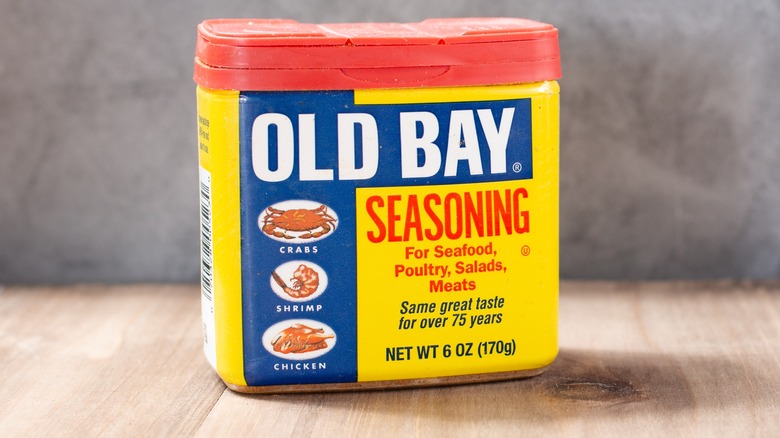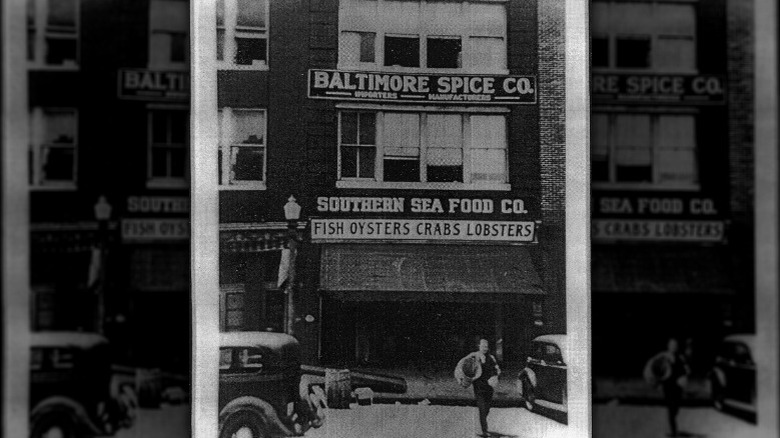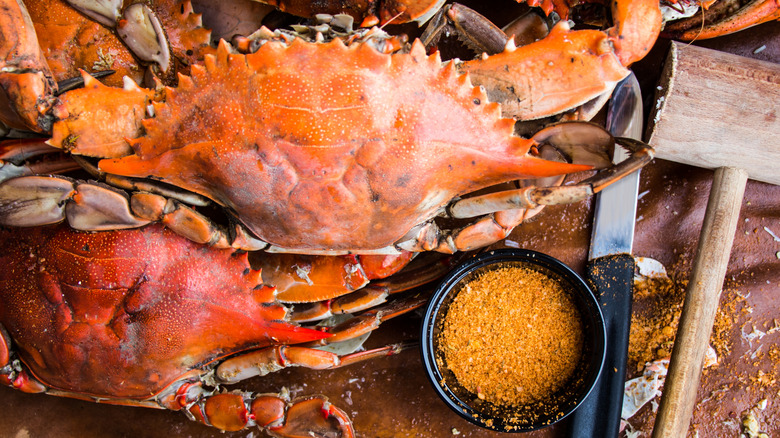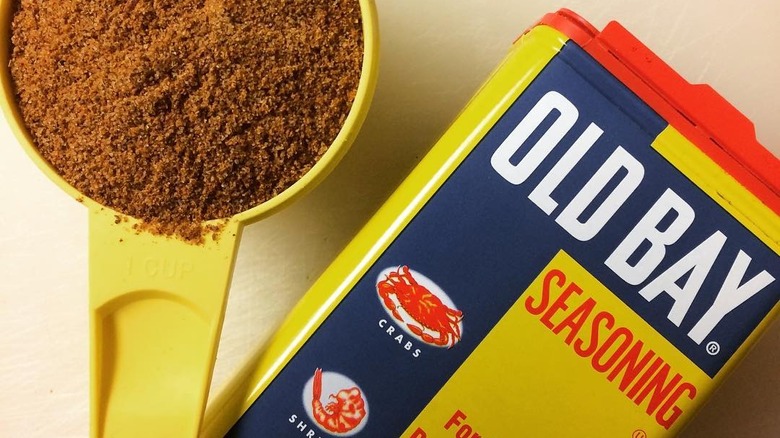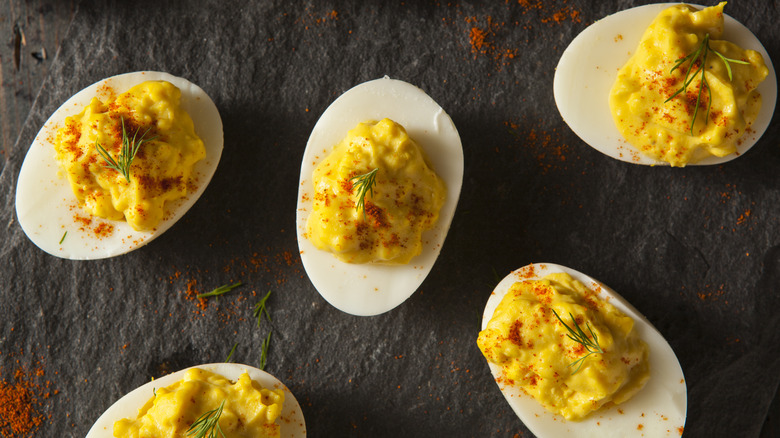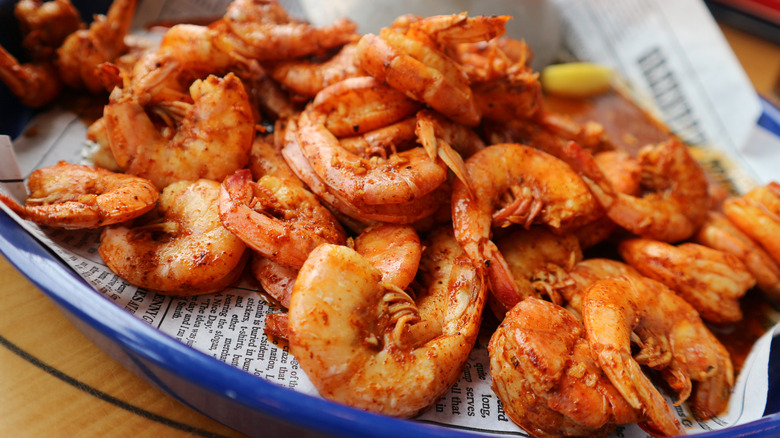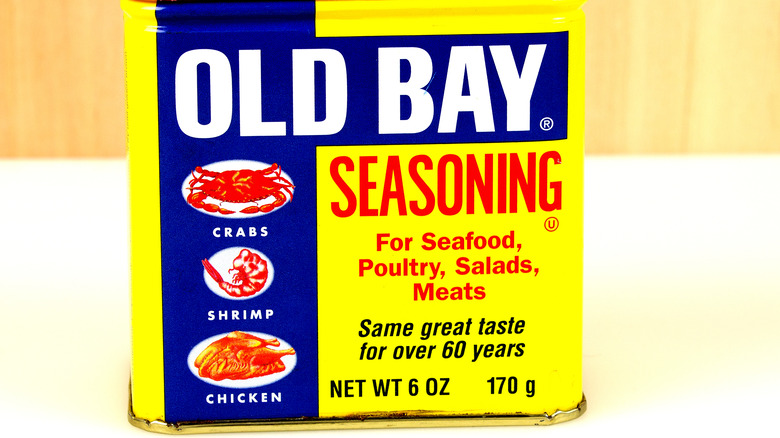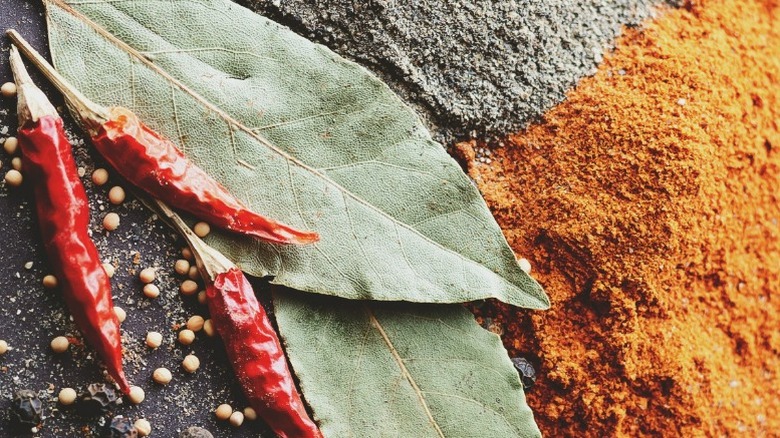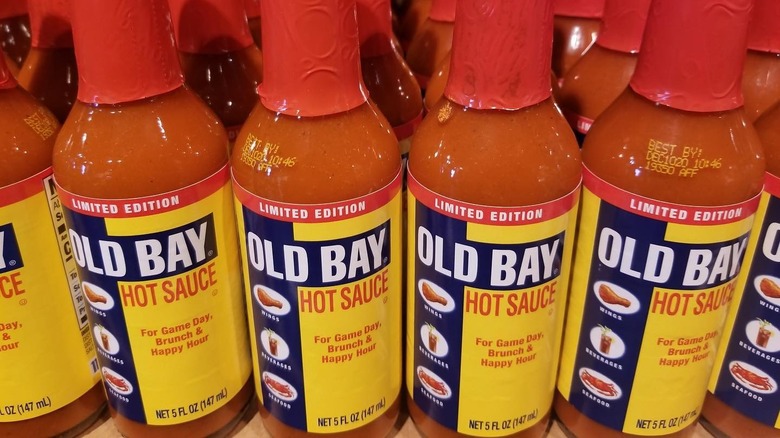The Untold Truth Of Old Bay Seasoning
Maryland blue crab fans (even those who prefer J.O.) know all about Old Bay Seasoning. The iconic Baltimore spice blend is good on seafood and so much more. It has become a nationally recognized brand because people who love it really love it. Duff Goldman even made an Old Bay cake.
Old Bay's recipe of 18 herbs and spices — mustard, paprika, celery salt, ginger, cinnamon, and cloves among them — is a closely guarded secret with origins as surprising as its makeup. Old Bay's inventor was a German Jewish refugee who created the enduring seafood seasoning as part of his own American dream. He had a connection to the McCormick spice company decades before they became the owners of the Old Bay brand.
While the salty, spicy, complex blend hasn't changed in over 80 years, Old Bay has come a long way from its humble beginnings by the Chesapeake. It's made its way into regionally beloved snacks from potato chips — Herr's uses authentic Old Bay Seasoning — to roasted peanuts and less likely offerings including The Charmery's Old Bay Caramel ice cream and Flying Dog Dead Rise beer. The seasoning itself remains a staple in spice racks not just around Maryland and the eastern shore, but across the United States (via Reddit).
Whether Old Bay is old news to you or you've never tried this compelling condiment, here's everything you need to know about it.
Old Bay was invented by a German Jewish immigrant
Gustav Brunn, formerly Brunngasser, could never have expected to become the inventor of one of America's iconic regional products. Born in Bavaria in 1893, he left school at the age of 13 to work for a leather tannery (via Baltimore Jewish Times). Eventually, he moved into the spice business and enjoyed success until the Nazis rose to power in the 1930s when Brunn's business — and Jewish citizens in general — began to suffer from antisemitic persecution.
Brunn and his immediate family were able to secure an affidavit from an uncle living in Baltimore, MD that allowed them to emigrate to the United States. They purchased steamship tickets and arranged transportation for their furniture, but before their departure date, Kristallnacht threatened their plans.
While their home was spared destruction, Brunn, like many other Jewish men, was arrested and interned in Buchenwald concentration camp, where he fell ill. His wife was able to secure his release by paying a hefty fee to a lawyer and showing proof of their imminent emigration.
Among the few possessions they took with them on the journey were an electric spice grinder and mixer, which, according to an interview conducted by the Jewish Museum of Maryland, had been rewired to work with the American electrical system. They arrived in Baltimore on December 28, 1938.
After nine months of struggle to find steady employment, Brunn started the Baltimore Spice Company in 1939. Old Bay made its debut in 1941.
Old Bay quickly became synonymous with Maryland blue crabs
The original location of the Baltimore Spice Company was one floor above Southern Seafood Co. and across the street from the Wholesale Fish Market of Baltimore, according to the Jewish Museum of Maryland. Brunn processed and sold single spices and blends of all kinds, including pickling mixtures and pastrami rubs. His specialty, which he'd perfected back in Germany, was sausage seasoning.
But it was inevitable that seafood seasoning would follow. Area vendors came to order custom blends for their steamed shrimp and crabs — fairly simple mixtures of mustard powder, black pepper, and salt (via Jmore). Brunn thought he could do better and developed his own formula that built on the basic combination of spices with sprinkles and pinches of numerous other ingredients until he had an incredibly complex blend.
It was tough to convince seafood vendors to buy it in the beginning, though. When he talked a crab seller into trying his seasoning and the man's business shot up, other vendors expressed interest too. The Baltimore Sun says the blend was originally known as Delicious Brand Shrimp and Crab Seasoning. A friend in advertising suggested Brunn rename it Old Bay after a steamship line that sailed between Baltimore and Norfolk, VA. The catchier name stuck and further solidified the seasoning's ties to the region.
Old Bay is now owned by McCormick, who once fired Gustav Brunn
The first iteration of the behemoth McCormick spice company was established in Baltimore in 1889. By 1939, it had grown from a one-room, door-to-door sales operation into a large corporation (via McCormick).
Before founding his own Baltimore Spice Company, Gustav Brunn was employed by McCormick & Company — for three days. He was fired, according to Saveur, for not speaking English well enough. In an oral history for the Jewish Museum of Maryland, his son Ralph claimed it was due to antisemitism.
Whatever the case, it's clear that Brunn did well for himself after establishing his own business. In 1980, when the Brunn family gave an interview to the Jewish Museum of Maryland, the Baltimore Spice Company was manufacturing more than 16,000 products and operating seven factories: four in the United States, one in the Dominican Republic, one in Costa Rica, and one in Israel.
But Gustav Brunn was getting older, and in 1985, at the age of 92, not long before he died, he finally sold his company — to Smith Corona Machines (via the Washington Post). Better known for manufacturing typewriters, Smith Corona also owned various other brands, including Durkee Foods, at the time. According to The New York Times, they eventually sold to UK-based Hanson Industries, and in 1990, Hanson Industries sold Old Bay to McCormick (via The Baltimore Sun). The undisclosed sum that McCormick paid was estimated to be many millions of dollars.
Old Bay contains 18 herbs and spices
Old Bay's exact composition is as much of a mystery as KFC's finger-licking secret formula, but we have plenty of clues to help us figure out precisely what Old Bay is made of.
Today, per McCormick, the official Old Bay ingredients label lists only celery salt (a mixture of ground celery seed and salt), spices "including red pepper and black pepper," and paprika. That single catch-all of "spices" is shorthand for a complex blend of different ingredients that go into the pleasantly gritty, brick-orange blend.
Dry mustard is part of the mix. Trace amounts of cinnamon, mace, ginger, cloves, and bay leaves (listed on older packages as laurel leaves, per The Baltimore Sun) are also all present. Cardamom is listed on a vintage Old Bay container on The Maryland Food Blog too. There was never a time when all 18 ingredients were disclosed on the packaging, but Gustav Brunn's son Ralph has been quoted as saying his father used small amounts of several unlikely spices, including nutmeg, in part to make it hard to reverse engineer his signature seafood seasoning (via the Jewish Times).
If you're wondering what Old Bay tastes like, it's fantastic: savory, aromatic, quite salty, and reasonably spicy. The presence of warm, slightly sweet spices balanced by the fairly modest amount of heat from red pepper and dry mustard harmonizes beautifully with the distinct flavor of celery seed.
Old Bay is good on so much more than steamed crabs
For steamed crabs and steamed shrimp, Old Bay is an undisputedly delicious seasoning — although, according to The Baltimore Sun, many Maryland and Eastern Shore restaurants use J.O. Seasoning, a similar but much cheaper-per-pound option.
But when it comes to how to use Old Bay Seasoning at home, your options are almost endless. Sprinkle some on deviled eggs, popcorn, or french fries for instant gratification. Use it to season any type of seafood you can grill, bake, broil, steam, or fry, and put it on grilled or roasted vegetables too. Use it as a rub for any meat, or for plant-based proteins. Mix it into chicken salad, shrimp salad, egg salad, or tuna for a big flavor boost, or just mix with some mayo for a spicy sandwich spread. Work it into crab cakes, of course, but also try it in the dredge for Old Bay fried chicken, like this recipe from Big Oven. Mix it into biscuits, cornbread, and fritters. It's essential in crab soup — and in Maryland crab dip — but you can also spike your ceviche with Old Bay. Ditto your Bloody Mary; try this Savory Simple recipe.
Just one caveat: If you're adding Old Bay to a recipe that doesn't specifically call for it, since it is a salt-heavy seasoning, you might want to omit some of the salt from the ingredients list. At the very least, taste before adding more salt.
Old Bay isn't the same as Cajun seasoning
While Old Bay Seasoning does have a lot in common with Cajun seasoning, one difference is that there is no single specific recipe for the latter, nor does it have such a concrete origin story (per PepperScale). However, they can be substituted for one another in a pinch.
Cajun tends to be far spicier and usually contains alliums in the form of onion or garlic powder (or both). Many Cajun seasoning recipes use oregano and thyme, which don't show up in the less herbaceous Old Bay Seasoning. Old Bay contains no dehydrated bell peppers, which do turn up in some Cajun seasoning blends, including McCormick's own version.
Old Bay is notable for its inclusion of several so-called sweet spices, like cinnamon and cloves, which you almost never find in earthier Cajun seasoning — though there are exceptions to every rule. The homemade Cajun seasoning recipe from Killing Thyme, for instance, actually calls for a few tablespoons of Old Bay as a flavor booster. Not authentic, but probably tasty.
In any case, if you find yourself fresh out and are looking for a good Old Bay substitute, you can get a similarly zesty, complex flavor from Cajun seasoning, Creole seasoning, seasoned salt like Lawry's, or any crab boil spice mix. Likewise, you can use Old Bay in place of any of those ingredients. Just know that it won't taste exactly the same (via Reddit).
Old Bay no longer comes in its iconic metal tin
For decades, Old Bay Seasoning came in a vibrant yellow, blue, and red metal tin — and while the label design is still the same, the container itself is now made from plastic. That may not seem like a huge deal, but it has in fact made many people quite upset.
McCormick made the change to Old Bay packaging back in 2017, when they noted that the new plastic container was BPA free, fully recyclable, and would reduce carbon emissions (via Facebook).
Detractors worried that it would make the seasoning inside taste different, though people who already regularly used Old Bay in plastic food service containers assured them it wouldn't. Others thought the plastic packaging would actually be worse for the environment, and speculated that the move had more to do with cutting manufacturing costs. Some simply lamented the loss of the metal tin's old-fashioned charm. Naturally, there was an entire Reddit thread about it.
Over four years later, you might think the furor would have died down, but there are still commenters bashing the plastic package, with some saying the lid has fallen off while they were shaking out seasoning. A recent reply to one such comment on the McCormick site said they are in the process of tweaking the package design, in part to ensure the lid stays firmly attached. However, there are no plans to bring back the metal Old Bay tin.
You can try making homemade Old Bay seasoning if you can't buy it
Barring supply chain issues, it's not so hard to come by Old Bay these days, even if you have to resort to buying it online. But if for some reason you can't find any, you can always try making it at home. There are a slew of Old Bay copycat recipes to choose from, though none are likely to be a perfect dupe. It's interesting to study the specific combos and ratios of spices different home cooks have settled on. A Couple Cooks calls for only eight ingredients, while Leite's Culinaria expands the ingredient count to 11 and Daring Gourmet gets closer to the original 18 components with a total of 16 herbs and spices.
You can also try reverse-engineering the secret formula yourself. The Q&A section of the Old Bay product page provides some helpful clues. One official reply there notes that "a complete ingredient listing is proprietary" with the caveat that "this information can be released to your doctor upon request" (via McCormick).
Even if you did want to put in that much work, of course, you'd never get the specific ratios. Still, this section of their site confirms that Old Bay contains ginger, bay leaves, mustard, cinnamon, and coriander. It also reveals that Old Bay does not contain onion, garlic, cumin, sesame, turmeric, sugar, starch, yeast, malt extracts, MSG, oregano, gluten, citrus, dairy, soy, tomato, or cilantro.
Old Bay hot sauce was a huge hit
While McCormick proudly pledges that the Old Bay recipe has never changed, the company hasn't been afraid to innovate. It has offered Old Bay with Lemon & Herb, Old Bay with Garlic & Herb, and an Old Bay Hot Seasoning, "a zesty blend of 18 herbs and spices" (which would suggest that it's the same formula as original Old Bay with the red pepper quotient increased). There's also a low-salt Old Bay Seasoning with 30% less sodium — or 95 mg per 1/4 teaspoon serving size, versus the original's whopping 145 mg.
But perhaps their most popular variation has been Old Bay Hot Sauce. It debuted in 2020 and sold out in under an hour (per Baltimore Fishbowl). The McCormick website crashed in the process. For those who missed out, Vice documented how bottles were listed for up to $50 on eBay, and 64-ounce jugs for up to $300 each.
PepperScale describes it as a Louisiana-style hot sauce with a vinegary tang and all the complexity of Old Bay itself plus added fire. The spice level is a bit too timid for their liking, while the sodium content is sky-high (which, frankly, is to be expected). Unlike Old Bay Seasoning itself, the hot sauce does contain garlic, which you can pick up in the aftertaste.
Luckily for hot heads crabby about missing out, the spicy elixir became a permanent offering in 2021.
